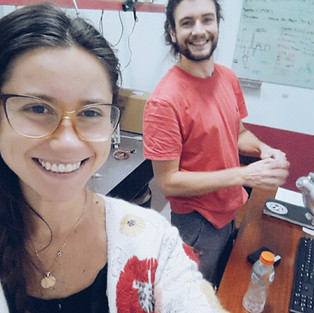New physics revealed by the first PMOKE microscope in🇦🇷
- Nirvana Belén Caballero
- Nov 1, 2020
- 2 min read
Updated: Oct 13, 2021
This is how happy a theoretician looks like when she is brought to the lab to meassure what she studies.
Thanks Lucas! :)
Since 2016 the first Polar Magneto-Optic Kerr effect microscope in Argentina is operative at the Bariloche Atomic Center. This technology allows us to capture optical images of ferromagnetic systems with micrometric resolution. Moreover, it allows us to study the dynamics of ferromagnetic interfaces under the effects of magnetic fields at velocities that expand over 10 orders of magnitude. Applications of these studies are, for example, the development and improvement of magnetic memories (generally used in satellites).

The first results obtained with the microscope where published by us in
Excess velocity of magnetic domain walls close to the depinning field
N. Caballero, I. Fernández Aguirre, L. J. Albornoz, A. B. Kolton, J. C. Rojas-Sánchez, S. Collin, J. M. George, R. Diaz Pardo, V. Jeudy, S. Bustingorry, and J. Curiale.
We probed the dynamics of ferromagnetic interfaces in the so-called creep regime in [Co/Ni] based multilayers grown in Thales, France.

In the creep regime, a highly non-linear velocity response is expected as a consequence of the interplay of the effects of disorder, temperature, and the interface elasticity. We observed this regime in [Co/Ni] samples at very low fields. Approaching the depinning field from below results in an unexpected excess velocity with respect to the creep law.

We analyzed these results using scaling theory to show that this speeding up of domain wall motion can be interpreted as due to the increase of the size of the deterministic relaxation close to the depinning transition. We proposed a phenomenological model to accurately fit the observed excess velocity and to obtain characteristic values for the depinning field, the depinning temperature, and the characteristic velocity scale for each sample.

This excess velocity was reported by other authors in many other ferromagnetic samples but never explained. Our theory provides a method to explain this phenomenon and on the practical side, it allows us to obtain sample characteristic values when deviations from the creep regime are observed.
Reference:
Nirvana Caballero, I. Fernández Aguirre, L. J. Albornoz, A. B. Kolton, J. C. Rojas-Sánchez,
S. Collin, J. M. George, R. Diaz Pardo, V. Jeudy, S. Bustingorry, and J. Curiale.
Excess velocity of magnetic domain walls close to the depinning field







Comments